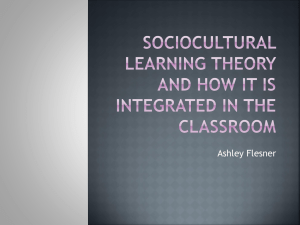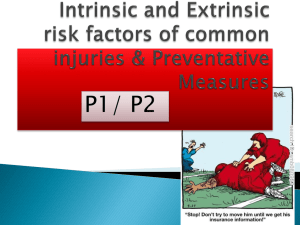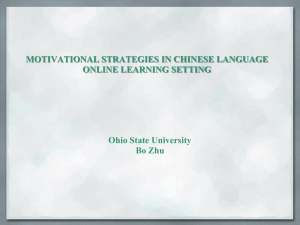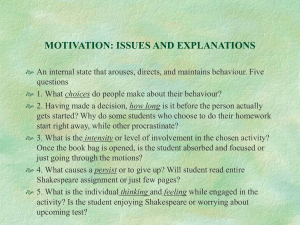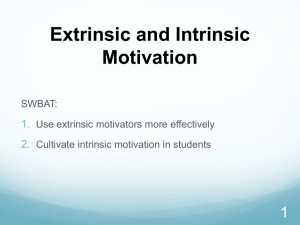Document
advertisement
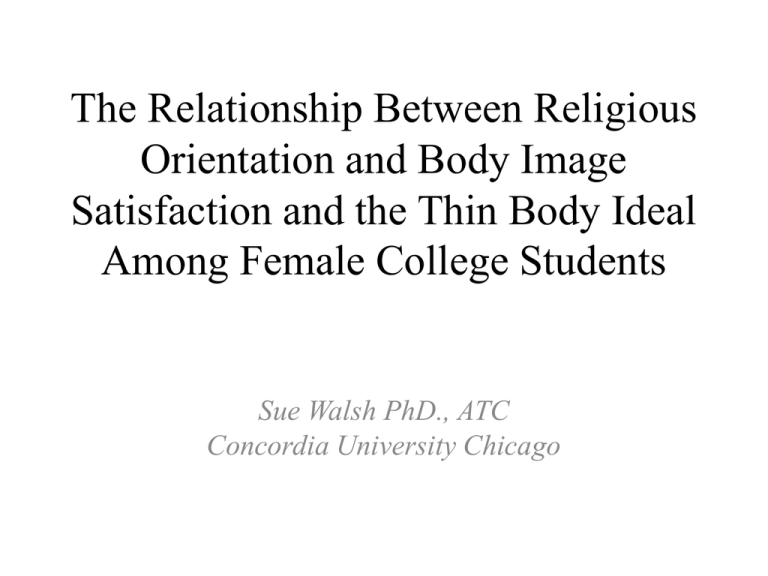
The Relationship Between Religious Orientation and Body Image Satisfaction and the Thin Body Ideal Among Female College Students Sue Walsh PhD., ATC Concordia University Chicago Agenda • • • • • • • • • • • Development Purpose Problem Sociocultural Theory Research Questions Procedures Variables Results Conclusions Limitations & Delimitations Future Research Development • Peter Walters PhD – Wheaton College • Harold Koenig M.D. – Duke University – Leading researcher on health and religion Purpose To investigate the relationship between religious orientation and the sociocultural attitudes towards appearance and body image satisfaction among female college students. Allport’s Religious Orientation • Gordon Allport's theoretical distinction between mature and immature religion (Allport and Ross ,1967) • Not all religious individuals are created equally: Individuals might engage in similar religious behaviors, such as church attendance, their underlying motives may differ, depending on the “maturity” of their respective “religious sentiments” (Hill & Hood, 1999, p 119) • Intrinsic-extrinsic scale to measure different religious orientations • Intrinsically religious – internalize and live their religion, and their religious motivation is found at the very core of his or her being. • Extrinsically religious – use religion as a means for a different end, such as: security, justification, sociability, distraction, or status; and that their motives for being religious rest on social or external values (Genia, 1998). Problem • Novel and lacking research – The relationship between religious orientation and sociocultural influences of body image. • Limited research – Investigating the interactions between the sociocultural and protective factors that intrinsic religious orientation may provide for young women. • (Boyatzis, et al., 2007; Jacobs-Pilipski et al., 2005; Mahoney et al., 2005) • Health and wellness education at private religious high schools and colleges. – Moral communities (Johnson & Mullins, 2006). – Understand the literature of Allport’s religious orientation: • Extrinsic Religious Orientation - Health-compromising • Intrinsic Religious Orientation - Health-promoting – (Forthun, 2003; Hathaway & Pargament, 1990) • Educators at religious institutions may become more aware of and focus on the risk factors associated with body image dissatisfaction. Sociocultural Theory • Dissatisfaction with physical appearance stems from: – the thin body ideal promulgated in Western societies – “body as object” vs. “body as process” orientation – the “thin is good” • Rewards for being attractive • Costs associated with being unattractive (Morris, 2003) • Mass Media • Strongest conveyors sociocultural assumptions – (Stice et al., 1994) • Religious Orientation: – Intrinsic Religious Orientation • Protective factor for: – Health disparities (e.g., alcohol abuse, depression) – Negative societal influences regarding physical appearance? – Extrinsic Religious Orientation • Health-compromising traits: anxiety, insecurity, and self-righteousness. – (Forthun, 2003; Koenig et al., 1998) Research Questions •What is the relationship between religious orientation and body image concerns among college female students? •What is the relationship between religious orientation and the “thin body ideal” among college female students? •What is the relationship between body image concerns and the “thin body ideal” among college female students? •What is the relationship between religious orientation, body image concerns and the “thin body ideal” among college female students? Procedures • Random Sample – e-mail link to Blackboard survey – female undergraduate students ages of 18 – 24 – response rate of 41%, (N=231) • A faith based University – incorporate religious faith into the mission, governance, administration, criteria for faculty hiring, curricula, student life, campus ministries, policies, and procedures of the university (Litfin, 2004). Variables • Independent Variables – Religious Orientation • Intrinsic Religious Orientation • Extrinsic Religious Orientation • Dependent Variables – Sociocultural attitudes towards appearance • • • • Internalization General Internalization Athletic Media as Pressure Media as Knowledge – Body Image Concerns • • • • Appearance Orientation Appearance Evaluation Overweight Preoccupation Self-Classified Weight Religious Orientation Scale Subscale Define Scored Intrinsic Religious Orientation (Continuous) Lives his or her religion not for their own purposes. High scores suggest a high degree on intrinsic religious orientation. Low scores suggest a low degree of intrinsic religious orientation. *Cronbach’s alphas in the mid .80s Extrinsic Religious Orientation (Continuous) * Cronbach’s alphas in the mid .70s Uses his or her religion for their own purpose (i.e., security, justification, sociability) High scores suggest a high degree of extrinsic religious orientation. Low scores suggest a low degree of extrinsic religious orientation. Multidimensional Body-Self Relations Questionnaire- Appearance Scales Subscale Define Scored Appearance Evaluation (Continuous) *Cronbach’s alphas .88 Individual’s reported feelings of attractiveness & satisfaction with ones looks. High scores suggest positive satisfaction with their appearance. Low scores suggest dissatisfaction with their appearance. Appearance Orientation (Continuous) Extent of investment in one’s appearance. High scorers place more importance on how they look and engage in extensive grooming behaviors. Low scorers, their looks are not as important to them & they don’t expend much effort to look good. Reflects fat anxiety, weight vigilance, dieting and eating restraints. High scores have high preoccupation with being overweight. Low scorers have a low preoccupation with being overweight. Reflects how one perceives and labels ones weight, from very underweight to very perception. A mean score of 3 reflects a normal weight perception. Higher scores reflect overweight over-weight perceptions. Low scores reflect underweight perceptions. *Cronbach’s alphas .85 Overweight Preoccupation (Continuous) *Cronbach’s alphas .76 Self-Classified Weight (Continuous) *Cronbach’s alphas .89 Sociocultural Attitudes Toward Appearance Questionnaire-3 Subscale Define Internalization – General (Continuous) Degree to which one internalizes the High scores suggest a high degree of societal emphasis of media influence internalization. related to TV, magazines and movies Low scores suggest a low degree. on appearance. *Cronbach’s alphas .92 Internalization – Athletic (Continuous) *Cronbach’s alphas .89 Pressure (Continuous) *Cronbach’s alphas .94 Knowledge (Continuous) *Cronbach’s alphas .94 Degree to which one internalizes the societal influence of athletic and sport figures on appearance. Scored Same as above Degree of pressure one feels from the High scores suggest high degree of media to conform to appearance pressure one feels from the media to standards. conform. Low scores suggest low degree to conform. Degree to which one uses the media as a knowledge informational source on body image. High scores suggest a high degree of the use of media as an information source. Low scores suggest a low degree. Demographics Variable n % Age 18 19 20 21 22 23 24 46 46 47 47 31 10 4 70 44 50 67 90 140 141 44 14 1 10 19 1.55 2.5 1.2 1.6 .49 2.05 1.87 38.8 60 Religion Lutheran Roman Catholic Protestant Muslim No Religion Other 20.1 30.3 19.0 21.6 28.9 Residence Commuter On-Campus SD 19.9 19.9 20.3 20.3 13.4 4.3 1.7 Class Freshmen Sophomore Junior Senior M 61.6 19.2 6 .4 4.3 8.3 Demographics (continued) Variable n % Ethnicity White, Non-Hispanic Black/African-American Hispanic Asian-Pacific Islander 187 18 24 1 22 34 28 42 42 31 17 6 7 126 64 34 1.3 .67 4.07 1.88 24.8 5.0 10.0 15.4 12.7 19.0 18.6 14.0 7.7 2.7 BMI Below 18.5 18.5 – 24.9 25 – 29.9 30 or greater SD 80.6 7.8 10.4 .4 Income Under $25,000 $25,000 - $39,000 $40,000 - $49,000 $50,000 - $ 74,000 $75,000 - $99,999 $100,000 - $124,999 $125,000 – 149,999 Over $150,000 Mean 3.0 54.5 27.7 14.7 Descriptive Statistics of Study Variables (N=231) Variable Min Max Mean SD Intrinsic 1.0 5.0 3.56 .832 Extrinsic 1.0 4.82 2.49 .679 Appearance Orientation 1.08 5.0 3.46 .664 Appearance Evaluation 1.14 5.0 3.23 .810 Overweight Preoccupation 1.0 5.0 2.65 .916 Self-Classified Weight 1.50 5.0 3.36 .715 Media as Information 1.0 4.56 2.96 .915 Media as Pressure 1.0 5.0 3.31 1.00 Internalization – Athletic 1.0 5.0 3.27 .913 Internalization – General 1.0 5.0 3.11 .942 Religious Orientation Body Image Concerns Sociocultural Attitudes Results Correlation - Intrinsic and Extrinsic Religious Orientation Extrinsic Religious Orientation Intrinsic Religious Orientation -.497** Note. ** p < .01 Hypotheses 1: Female college students who report higher scores of intrinsic religiosity will have lower body image concerns. Correlation Matrix Intrinsic Religious Orientation & Body Image Concerns Subscales Appearance Orientation Intrinsic Religious Orientation Note. ** p < .01 -.119 Appearance Evaluation .195** Overweight Self-Classified Preoccupation Weight -.192** .052 Hypothesis 2: Female college students who report higher scores of extrinsic religious orientation will have higher body image concerns. Correlation Matrix Extrinsic Religious Orientation & Body Image Concerns Subscales Extrinsic Religious Orientation Note. ** p < .01 Appearance Orientation Appearance Evaluation .296** -.113 Overweight Self-Classified Preoccupation Weight .236** .022 Hypothesis 3: Female college students who report higher scores of intrinsic religiosity will have lower sociocultural influence scores. Correlation Matrix Intrinsic Religious Orientation & Sociocultural Attitudes Subscales Intrinsic Religious Orientation Note. ** p < .01 * p < .05 Information Pressure Internalization Internalization Athletic General -.197* .064 -.082 -.225** Hypothesis 4: Female college students who report higher scores of extrinsic religiosity will have higher sociocultural attitudes scores. Correlation Matrix Extrinsic Religious Orientation & Sociocultural Attitudes Subscales Extrinsic Religious Orientation Note. ** p < .01 Information Pressure Internalization Athletic Internalization General .193** .096 .125 .181** Hypothesis 5: Female college students who report higher sociocultural attitudes scores will have higher positive body image concerns. Correlation Matrix Sociocultural Attitudes Subscales & Body Image Concerns Subscales Appearance Orientation Appearance Evaluation Overweight SelfPreoccupation Classified Weight Information .361** -.180* .270** .061 Pressure .393** -.488** .618** .288** Internalization Athletic .164* -.261** .305** .078 Internalization General .436** -.426** .575** .096 Note. ** p < .01 * p < .05 • Hypothesis 6: Higher levels of intrinsic religious orientation scores and lower levels of sociocultural attitudes scores will predict lower body image concerns in female college students. • Hypothesis 7: Higher levels of extrinsic religious orientation scores and higher levels of sociocultural attitudes scores will predict higher body image concerns in female college students. Correlation Matrix among Dependent Body Image Concerns Subscales & Demographic Variables Variables Age Class Appearance Orientation .029 .058 Residence Religion Ethnicity BMI Income -.091 .130* -.017 .022 .014 Appearance Evaluation -.013 .084 .022 .031 .201** .432** OverweightPreoccupation .068 .137* -.096 .126 -.103 .344** .039 Self-Classified Weight .103 .127 -.020 .021 -.032 .755** -.081 Note. ** p < .01 * p < .05 .063 Hierarchal Regression Analysis – Dependent variable Appearance Orientation Variables ΔR2 Step 1 .017 B Sig 95% CI .130 .048 [.004, 1.108] Religion .272 .144 [-.138, .934] Extrinsic .282 .000 [.167, .435] Extrinsic .212 .000 [.098, .347] Information .123 .093 [-.021, .259] Pressure .166 .073 [-.018, .396] Internalization athletic -.090 .173 [-.382, .069] Internalization general Total R2 .230 .023 [.008, .357] Religion Step 2 .078 Step 3 .175 Note. B = Standardized .270 Hierarchal Regression Analysis – Dependent Variable Appearance Evaluation Variables ΔR2 Step I .186 B Sig 95% CI -.432 .000 [-.626, -.367] -.431 .000 [-.623, -.370] .194 .001 [.064, .233] BMI -.367 .000 [-.536, -.294] Intrinsic .135 .013 [.022, .183] Information .129 .060 [-.005, .172] Pressure -.241 .008 [-.344, -.060] Internalization athletic -.035 .556 [-.195, .091] Internalization general -.265 .006 [-.280, -.025] BMI Step II BMI .038 Intrinsic Step III Total R2 Note. B = Standardized .177 .401 Hierarchal Regression Analysis – Dependent Variable Overweight Preoccupation Variables ΔR2 Step I .125 B Sig 95% CI BMI -.331 .000 [.151, .334] Class .080 .206 [-.135,.623] BMI .309 .000 [.137, .317] Class .092 .137 [-.090, .652] Intrinsic -.124 .078 [-128, .007] Extrinsic .142 .045 [.001, .139] BMI .238 .000 [-.536, -.294] Class .019 .708 [ .132 , .358] Intrinsic -.052 .358 [-.080 .029] Extrinsic .107 .050 [-.002, .107] Information -.171 .006 [-.131, -.022] Pressure .350 .000 [.097, .271] Internalization athletic -.009 .867 [-.093, .079] Internalization general .377 .000 [.088, .239] Step II Step III Total R2 Note. B = Standardized .052 .328 .505 Hierarchal Regression Analysis – Dependent variable Self-Classified Weight Variables ΔR2 B Sig 95% CI .755 .000 [.737, .241] .727 .000 [.183, .233] .121 .006 [.007, .042] Step I .570 BMI Step II .014 BMI Pressure Total R2 Note. B = Standardized .584 Conclusions Intrinsic Religious Orientation • Consistently correlated with less influence from sociocultural attitudes towards appearance and greater body image satisfaction. • Correlations mild to moderately significant, in support of the research hypothesis. • May promote: – healthy sense of self-worth independent of the sociocultural attitudes towards appearance that can lead to body image dissatisfaction. – thinking of the body as holy and sacred and provides a cognitive framing that can enhance body image (Boyatzis et al, 2007). • Explain only a small amount of the variance in only Appearance Evaluation. • KEY – Religious supporters need to look at and understand all the dimensions of body image and the sociocultural influences when educating girls and young women on body image satisfaction and its influences. Extrinsic Religious Orientation • Consistently correlated with more influence from sociocultural attitudes towards appearance and body image dissatisfaction in female college students. • Correlations were mild to moderately significant and in support of most of the research hypothesis. • Explained some of the variance in Appearance Orientation and Overweight Preoccupation. • Surprising were the results from the correlation and regression results of extrinsic religious orientation due to lack of focus. • May lack any guiding principles over the influences of sociocultural attitudes towards appearance that can promote dissatisfaction with one’s own body. • Can be associated with a way of construction a worldly view on body image that can lead to dissatisfaction. Sociocultural Variables • Sociocultural variables were significantly correlated with body image concerns. • Internalization general explained the majority of variance in body image concerns. – The societal emphasis of appearance through media related influences, such as TV, magazines, and movies were found to place more importance on their looks, feel less satisfied with their appearance and were more likely to be preoccupied with being overweight. – Results, consistent with other studies Demographic Variables • Carefully chosen – Significant correlations – Explained most of the variance: • appearance evaluation, overweight preoccupation and self- classified weight. • Women with a higher BMI felt lower feelings of attractiveness and lower satisfaction with one’s looks, were more likely to diet and carryout excessive eating restraints and labeled themselves as overweight. • Results, consistent with other studies Limitations & Delimitations Study is limited to: Study is delimited to: • Self - report may lead to social desirability bias in respondents. •College aged students enrolled at the university used for this study. • Not experimental. •Research of female’s self-reported measures of the study variables. Future Research • Provide some support for the relationship between religious orientation and the sociocultural attitudes towards appearance and body image satisfaction. • Theory driven research and validated measures of religiosity. • Results may foster new ideas and growth within the field of psychology and religion. • A similar study with a diverse religious and ethnic sample (secular institution). • Scale that measure religious development. • Longitudinal research comparing a religious sample and a secular sample. • Participants could be followed from middle school through their college years. References • Boyatzis, C., Kline, S., & Backof, S. (2007). Experimental Evidence that Theistic- Religious Body Affirmations Improve Women's Body Image. Journal for the Scientific Study of Religion, 46 (4) 553 564. • Boyatzis, C. J., & McConnell, K. M. (2006) Quest orientation in young women: Age trends during emerging adult and relations to body image an disordered eating. Internal Journal for the Psychology of Religion. 16(3), 197 - 207. • Forthun, L. F., Pidcock B. W. & Fisher J. L. (2003). Religiousness and disordered eating: does religiousness modify family risk? Eating Behaviors, 4 (1) 7 – 26. • Hathaway, W., & Pargament, K. (1990). Intrinsic religiousness, religious coping, and psychosocial competence: A covariance structure analysis. Journal for the Scientific Study of Religion, 29, 423441. • Jacobs - Pilipski, M. J., Winzelberg, A., Wilfey, D. E., Bryson, S. W., & Barr, T. C. (2005). Spirituality among young women at risk for eating disorders. Eating Behaviors, 6(4) 293 – 300. References (continued) • Johnson, M.A., & Mullins, P. (2006). Moral communities: Religious and secular. Journal of Community Psychology, 18(2) 153 – 166. • Liftin, D. (2004). Conceiving the Christian College. Grand Rapids: William B. Eerdmans Publishing Company • Mahoney, A., Carels, R. A., Pargament, K. I., Wachholtz, A., Leeper, L. E., Kaplar, M., & Frutchey, R. (2005). The sanctification of the body and behavioral health patterns of college students. The International Journal for the Psychology of Religion, 15(3), 221-238. • Morrison, T. G., (2004). Body-image evaluation and body-image investment among adolescents: a test of sociocultural and social comparison theories. Adolescence, 39, 573-91. • Stice, E., Schupak-Neuberg, E., Shaw, H. E., & Stein, R. I. (1994). Relation of media exposure to eating disorder symptomatology: An examination of mediating mechanisms. Journal of Abnormal Psychology, 103, 836-840. • Tiggemann, M., & Pickering, A. S. (1996). Role of television in adolescent women's body dissatisfaction and drive for thinness. International Journal of Eating Disorders, 20, 199 - 203.


